COVID – 19 Advice for Your Recovery
COVID – 19 Advice for Your Recovery
Information for patients, Physiotherapy Department
Recovery time and symptoms of COVID-19 can be different for everyone. Length of recovery is not necessarily related to severity and symptoms may vary.
If new or ongoing symptoms do occur that are causing you concern you should always seek medical advice and support.
This webpage includes advice on how you can manage some of the common symptoms and gradually return to your daily activities.
Breathlessness
People are often breathless on activity and if this is worse than normal this may cause anxiety. Knowing how to control your breathing can help you remain calm. The following techniques may help:
Nose Tummy Breathing
Nose Tummy Breathing is a very efficient way to breathe.
Rest a hand on your tummy and feel your tummy rise as you breathe in through your nose, then breathe out slowly through your nose.
Pause and let the next breath come.
As you become more comfortable with this you will find that your breathing may slow and your breaths become deeper.
You can use nose tummy breathing in any position. Practicing when you feel at your best will help you to do this more easily when your breathlessness increases.
Positioning
There are a number of positions which you may find helpful when you are breathless.
Sit in a chair, or sit high up in the bed.
Drop your shoulders and let your arms go heavy. Place your hands with your palms facing upwards on your knees.
Think about your nose tummy breathing.
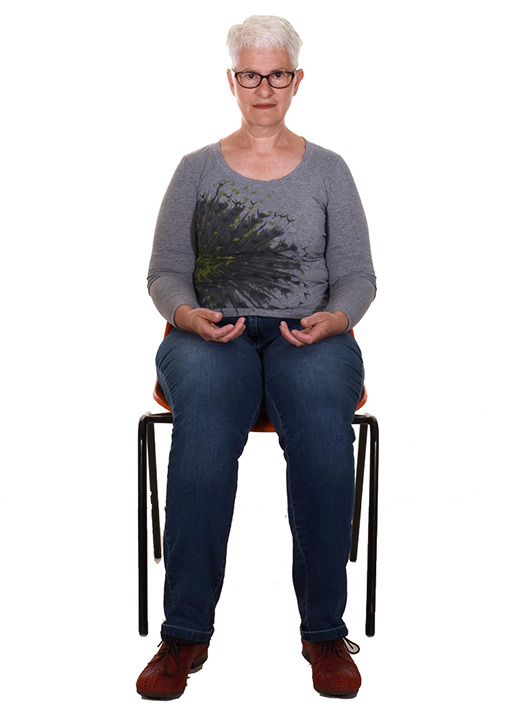
Sit in a chair with a table in front of you.
Keep your back straight and lean forward with your forearms on the table. Rest on your forearms and drop your shoulders.
Think about your nose tummy breathing.
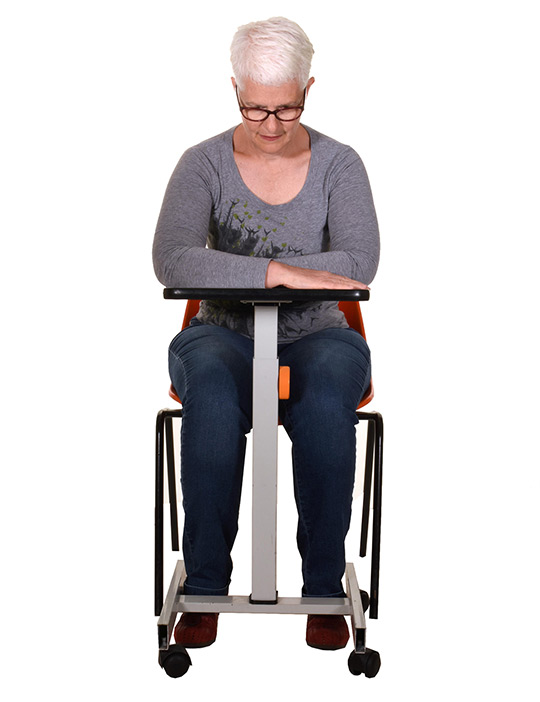
Lie on your side whilst propped-up by pillows. Place your top arm on a pillow in front of you and your top leg on another
pillow. Think about dropping your shoulders and using nose tummy breathing.
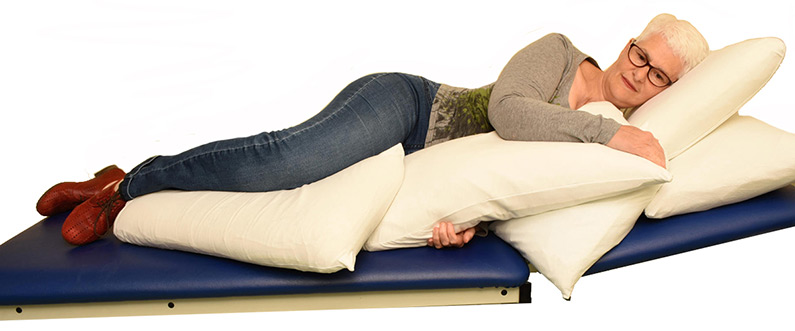
Stand and lean forward resting your forearms on a work surface or high
windowsill. Drop your shoulders and think about nose tummy breathing.
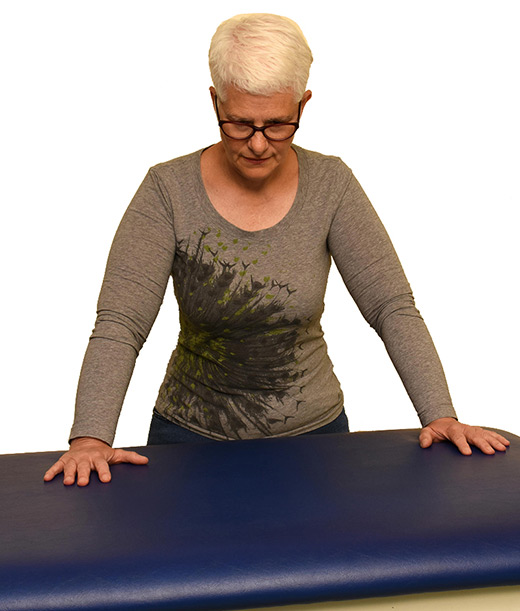
Some people find lying on their tummy can help their breathlessness.
Only try this if you are normally comfortable lying in this position and can move from lying on your back to lying on your tummy easily

Quick Relaxation
If you feel stressed or panicked you can try this quick exercise:
STOP
- STOP the activity you are doing
DROP
- DROP your shoulders
DROP your jaw slightly
FLOP
- Think about letting your body FLOP
- Carry out your nose tummy breathing
Eating and Drinking
You may feel your breathlessness is worse when you eat or drink.
- It is important to keep yourself well hydrated. Drink small sips of fluid regularly throughout the day
- If possible sit at a table to eat your meals. This helps to keep your chest “open”
- If your find eating is making you short of breath or tired, eat small portions of food regularly throughout the day
- Think about the type of food you eat. Avoid chewy food and try eating food with a soft texture or food with a sauce like soup, scrambled eggs or mince and potatoes
Cough
Coughing is the body’s way of protecting our lungs and getting rid of things that irritate them. This is a normal and important function. However, following some infections we can be left with a dry cough because our lungs have been irritated. It can be difficult to control your cough, however there are a few techniques which may help.
- Keep yourself well hydrated by drinking small sips of water throughout the day and reducing caffeine and alcohol intake.
- Avoid things that make you cough, for example:
- Smoking and smoky atmospheres.
- Use of air fresheners or strong smelling candles.
- Strong perfumes or deodorants.
- Carry out Nose Tummy Breathing if you are moving to an area with a different temperature.
- Carry out Nose Tummy breathing during gaps between coughs. Breathing through your mouth can be quite irritating for your lungs and may make you cough more. Gently blowing the breath out, as if you were whistling can also help.
- Keep a glass of water or a sugary drink handy. If you feel yourself starting to cough have a sip. This can soothe your throat. Sucking a sugary sweet may also help.
- If you have a runny nose, blow your nose if required.
- Try not to sniff.
- If you cough when you go to bed consider using some of the positions discussed above to ease your breathing.
If you feel you need further advice regarding your cough please contact your GP.
Returning to Your Normal Activity Levels
Pacing
It is important to gradually return to activity after a period of illness. Remember, activity can be both physical and mental.
You should listen to your body, if an activity feels strenuous you may realise that this is too much for that day. It may be appropriate to try this activity again the next day if you feel better.
It can be very frustrating as your mind may feel that you should be able to achieve more than your body is allowing you to. Try not to put pressure on yourself by thinking “I must” or “I should”. This can lead to a cycle of doing too much when you feel better, followed by a time where you may feel worse having over done things. This may impact how you feel about your recovery. If you recognise this pattern or feel negative or self-critical about your activity levels, it might be helpful to get some guidance for your recovery. This can be discussed with your GP.
Pacing lets you plan your activity over the course of a day. Spreading activity and rest evenly throughout the day will allow you to gradually increase your activity. For example, having a shower at 10am, a walk at 2pm and reading a book or using your computer in the evening may feel easier than trying to fit everything in before lunch.
Sleep is also a very important part of your recovery. Consider your sleep pattern and aim to go to bed and get up around the same time each day. Try to avoid caffeine in the evening as this may affect your sleep.
This may all sound complicated but an activity diary can help with these routines. Simply add activities you have completed during the day and think about what you may wish to do tomorrow.
Treat yourself kindly
We recognise this isn’t easy, so try to take some time to do things that you enjoy and that you might find rewarding rather than always focusing on the tasks you “should be able to do”
Exercise
Once you are managing everyday activities, you may feel ready to start exercising.
Ensure you increase your activity and exercise levels gradually. You may feel tired at first, so keep listening to your body. If you get tired, stop and take a rest, then resume again once you feel better. You may benefit from a Home Walking and/or a Home Exercise Programme.
Home Walking Programme
Remember to adhere to all guidelines that are in place with regards to social distancing and isolation.
If your walking is very limited, do as much as you feel able to do. Walking short distances regularly in the house is better than sitting for long periods of time without moving.
If you can, start by walking for around five minutes at a comfortable pace and increase this by a couple of minutes each day. You should
not feel too breathless to talk, or very tired.
It is OK to feel slightly tired after you exercise, but you should not still feel tired the next day.
If you are able to, build up your walking to around 30 minutes on five or more days of the week. This can be divided into 15 minutes twice or 10 minutes three times a day, if necessary.
Home Exercise Programme
Frequency
To start with it‘s better to exercise little and often.
Short but frequent bouts of exercise maybe easier for you.
- Repeat each exercise five times
- If this is too difficult, do three
- If it is too easy add two!
If any exercise causes you a problem, STOP.
if you are steady enough you can progress exercises 1-3 from sitting to standing.
Exercises
1.) Shoulder Circles –
Roll your shoulders forward in a circle then roll your them backwards in a cirlce.
Do whilst sitting, or you can progress to standing.

2.) Bicep Curls –
Do whilst sitting then progress to standing.
Hold a small bottle of water and slowly bend and straighten your elbows.

3.) Arm raises to the side –
Sit or stand for this exercise. Hold a light weight, start with your hands by your side, lift away from your side up to shoulder level.

4.) Leg Extensions –
In a sitting position.
Slowly straighten your knee, hold for a count of three and relax.

5.) Mini Knee lifts –
Sit up straight in your chair, feet flat on the floor and place your hands on your knees.
Lift one foot ½ inch off the floor then slowly replace it. Repeat with the other foot.
This will work your back and tummy muscles.

6.) Sit to stand –
Begin sitting towards the edge of your chair and lean forward: stand up slowly then sit back down carefully, keep your feet on the floor at all times.
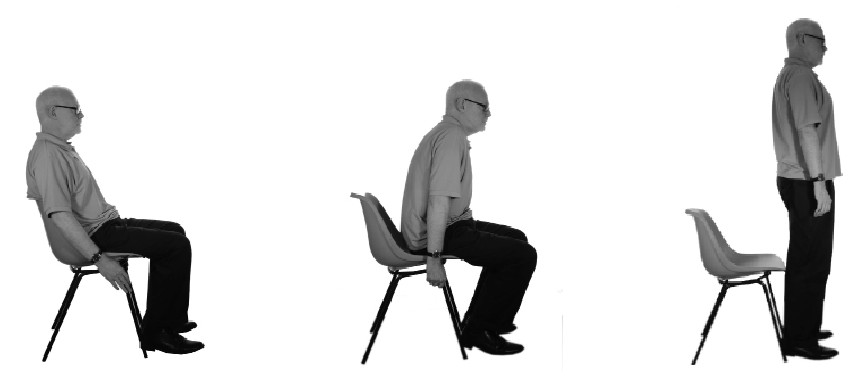
Remember
- Wait at least one hour after a meal before exercising
- Be aware of weather conditions. If winds and cold weather are unavoidable, wrap-up well with a scarf across your throat and mouth. If the weather is very warm, avoid exercising in the hottest part of the day and take a bottle of water with you
- Do not ignore any symptoms such as undue breathlessness
or excessive tiredness - You can continue to increase your walks as long as you build
up the time gradually - If you are walking a dog, you need to walk at your own pace
Long COVID
After catching COVID-19 people usually start to feel better in a few weeks, unfortunately some people take longer to get better.
Ongoing or new symptoms of COVID-19 may change and come and go over a longer period of time. To describe those types of symptoms health care professionals may use the term long COVID.
Long COVID usually means signs and symptoms that last more than four weeks.
These types of long COVID symptoms may require a different management plan. Further information and advice on this can be found at:
Returning to Work
If you are self-employed or work from home, resist the urge to start work too early in your recovery. Your GP may be able to advise you about your return to work.
The length of time you need to remain off work will depend on your progress.
If you have a physically demanding or stressful job you may need to stay off work for a longer period. Where possible, leave the decision until you feel able to cope with weighing up all your options.
A phased return to work may be recommended. This means that you gradually build up your hours and days, with lighter duties as appropriate. This would be discussed with your manager and /or Occupational Health.
Do not be surprised if you find yourself tired when you return to work.
COVID – 19 Advice for Your Recovery Leaflet
Printable PDF
If you need this information in a different format email info@lanarkshire.scot.nhs.uk or contact our general enquiry line on 0300 3030 243.
Further health information
NHS inform provides health information about illnesses, tests, treatments, operations and services for the public in Scotland.
- www.nhsinform.co.uk
- Telephone: 0800 22 44 88
Your Feedback – comments, concerns and complaints
NHS Lanarkshire is committed to improving the service it provides to patients and their families. We therefore want to hear from you about your experience. If you would like to tell us about this please visit our feedback page.


